How to identify fake letters like "A Spreadsheet Has Been Shared"
Phishing/ScamAlso Known As: A Spreadsheet Has Been Shared phishing email
Get free scan and check if your device is infected.
Remove it nowTo use full-featured product, you have to purchase a license for Combo Cleaner. Seven days free trial available. Combo Cleaner is owned and operated by RCS LT, the parent company of PCRisk.com.
What is "A Spreadsheet Has Been Shared"?
During analysis of the email, we concluded that it is a deceptive message posing as invoice-related correspondence. Scammers crafted it to deceive recipients into divulging personal information on a fraudulent website. Such emails fall under the category of phishing emails. Recipients should ignore these emails to avoid possible consequences.
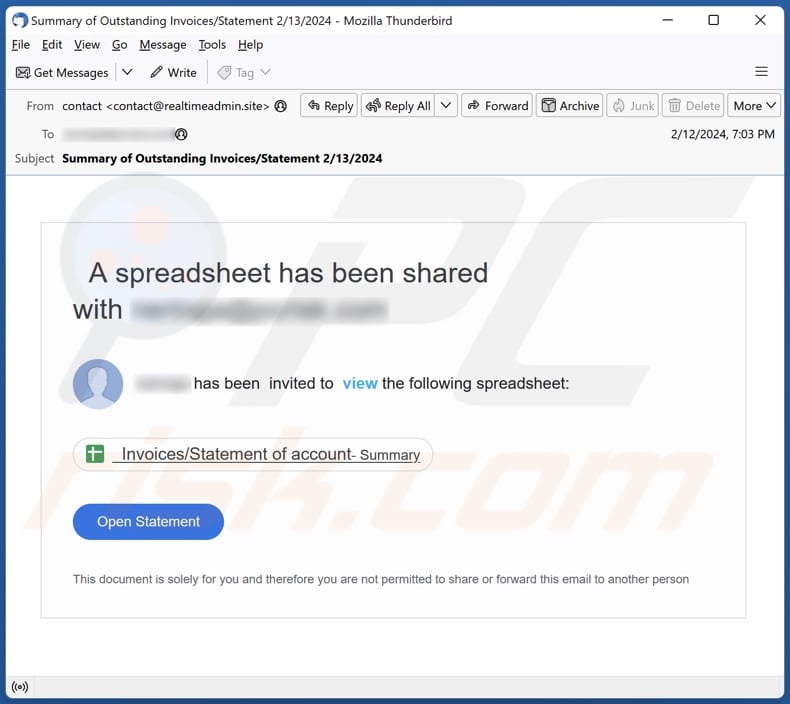
More about the "A Spreadsheet Has Been Shared" scam email
This phishing email masquerades as a legitimate notification regarding outstanding invoices or statements, with a subject line indicating urgency and relevance. It claims that a spreadsheet has been shared with the recipient.
The email prompts the recipient to open the spreadsheet titled "Invoices/Statement of account- Summary" by clicking on a link labeled "Open Statement". It emphasizes that the document is intended solely for the recipient and prohibits sharing or forwarding to others.
However, the email leads to a deceptive website designed to trick recipients into providing personal (login credentials). When recipients click the "Open Statement" button, it directs them to a counterfeit Yahoo Mail (or other service) sign-in page, prompting users to input their email address and password.
When scammers successfully obtain email account login credentials from unsuspecting individuals, they gain unauthorized access to the victim's email accounts. With this access, scammers may send out spam, phishing emails, or malware to the victim's contacts, perpetuating the scam further and potentially compromising more accounts.
Also, scammers can use the login credentials to access sensitive personal information contained within the victim's email account. This could include financial data, passwords for other online accounts, personal correspondence, or even sensitive documents. Additionally, they may hijack accounts linked to the email account and try to access other accounts using the same login credentials.
| Name | A Spreadsheet Has Been Shared Email Scam |
| Threat Type | Phishing, Scam, Social Engineering, Fraud |
| Fake Claim | The sender has shared a spreadsheet with the recipient |
| Related Domains | sales5rrt[.]digital, haobashi[.]top |
| Disguise | Email regarding an invoice |
| Symptoms | Unauthorized online purchases, changed online account passwords, identity theft, illegal access of the computer. |
| Distribution methods | Deceptive emails, rogue online pop-up ads, search engine poisoning techniques, misspelled domains. |
| Damage | Loss of sensitive private information, monetary loss, identity theft. |
| Malware Removal (Windows) |
To eliminate possible malware infections, scan your computer with legitimate antivirus software. Our security researchers recommend using Combo Cleaner. Download Combo CleanerTo use full-featured product, you have to purchase a license for Combo Cleaner. 7 days free trial available. Combo Cleaner is owned and operated by RCS LT, the parent company of PCRisk.com. |
Similar emails in general
Emails of this type often employ urgent or enticing subject lines to grab attention, such as warnings of account security breaches, outstanding invoices, or attractive offers. Also, they impersonate well-known companies or institutions, using logos, branding, and language that closely resemble legitimate communications.
They can contain hyperlinks or attachments that lead to fraudulent websites or even malware downloads. Examples of deceptive emails aimed at stealing information are "American Express - Call to Reset Your Account", "OneDrive - You Received Some Files", and "Price And Stock Availability".
How do spam campaigns infect computers?
Malicious actors orchestrating email-based malware campaigns disseminate emails containing malicious attachments or hyperlinks intended to initiate malware downloads or deployment. Often masquerading as innocuous documents or images, those attachments can initiate infections upon opening.
Links within these emails may redirect users to fraudulent websites or download portals harboring malicious payloads, thus facilitating malware infiltration onto their devices.
Executables (.exe), scripts (.js or .vbs), documents (.docx or .pdf), compressed files (.zip or .rar), and shortcuts (.lnk), are files commonly exploited by threat actors for malware distribution. However, not all malware-laden files initiate infections immediately upon opening.
How to avoid installation of malware?
Exercise prudence and doubt when engaging with questionable emails originating from unfamiliar senders, particularly if they include attachments or hyperlinks. Employ a trusted antivirus program and ensure it is consistently updated to identify and thwart potential risks effectively. Exercise caution regarding advertisements, pop-ups, and analogous content encountered on dubious websites.
When acquiring files and software, rely on official websites and reputable stores, refraining from utilizing alternative sources like peer-to-peer networks, third-party download platforms, or dubious websites. Maintain the operating system and installed applications up to date to bolster security measures. If you have already opened malicious attachments, we recommend running a scan with Combo Cleaner Antivirus for Windows to automatically eliminate infiltrated malware.
Text presented in the "A Spreadsheet Has Been Shared" email letter:
Subject: Summary of Outstanding Invoices/Statement 2/13/2024
A spreadsheet has been shared with ********
Unknown profile photo
******** has been invited to view the following spreadsheet:
Invoices/Statement of account- SummaryOpen Statement
This document is solely for you and therefore you are not permitted to share or forward this email to another person
Phishing website used in this scam:
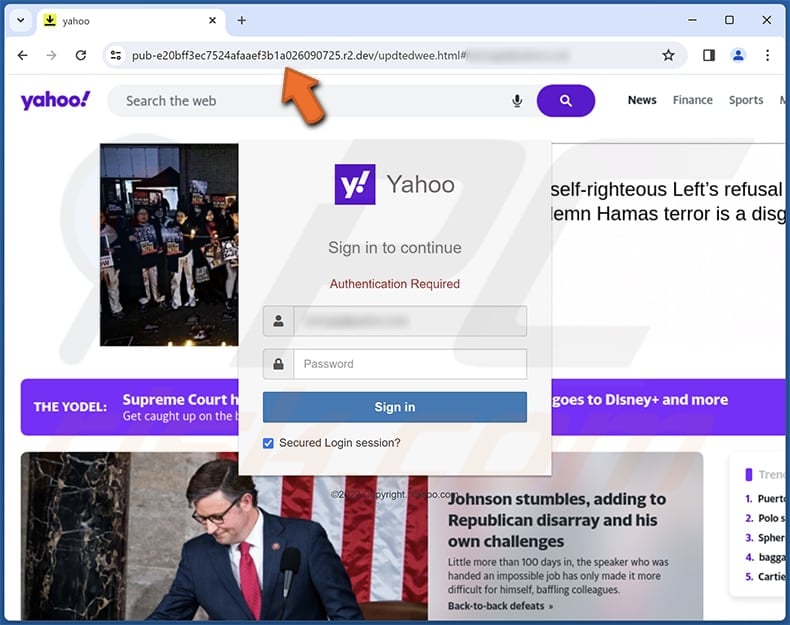
Other examples of spreadsheet-themed spam emails:
Sample 1:
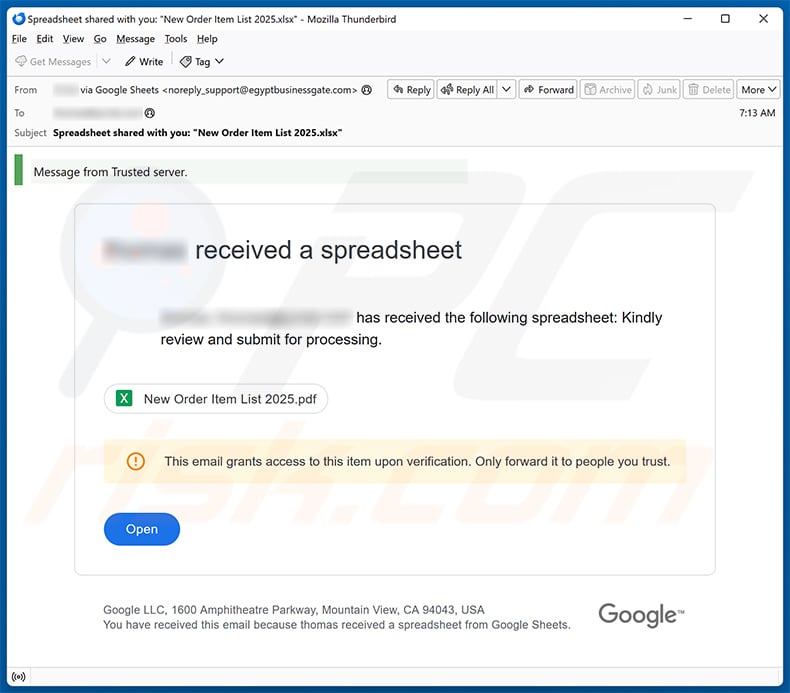
Text presented within:
Subject: Spreadsheet shared with you: "New Order Item List 2025.xlsx"
******** received a spreadsheet
********, ******** has received the following spreadsheet: Kindly review and submit for processing.
New Order Item List 2025.pdf
This email grants access to this item upon verification. Only forward it to people you trust.
Open
Google LLC, 1600 Amphitheatre Parkway, Mountain View, CA 94043, USA
You have received this email because ******** received a spreadsheet from Google Sheets. Google
Screenshot of the promoted phishing site:
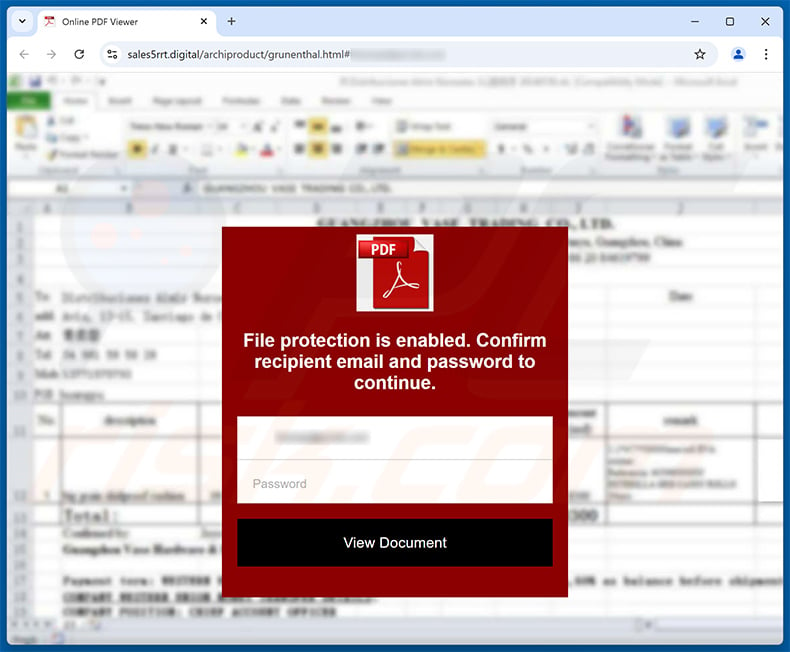
Sample 2:
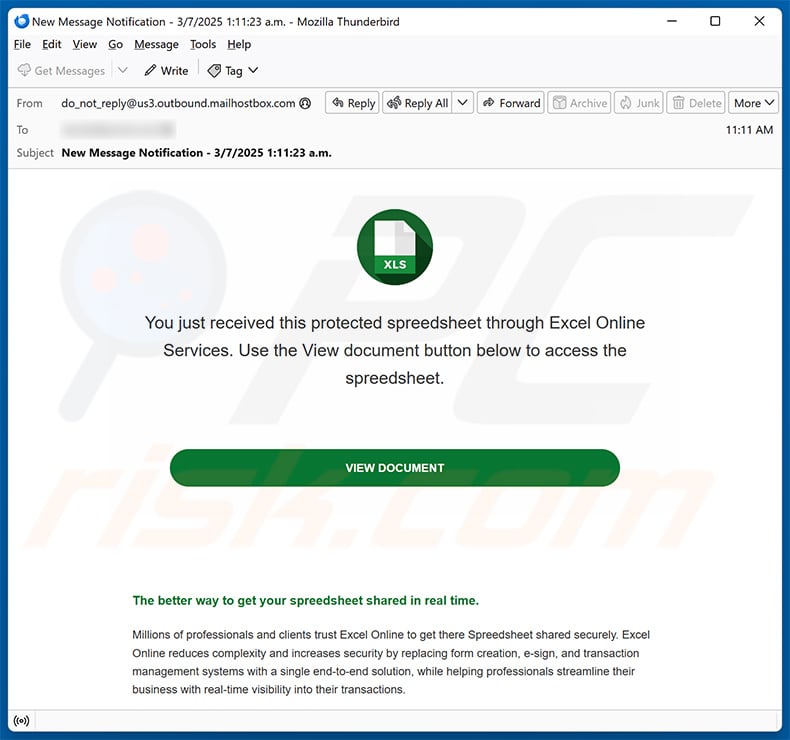
Text presented within:
Subject: New Message Notification - 3/7/2025 1:11:23 a.m.
You just received this protected spreedsheet through Excel Online Services. Use the View document button below to access the spreedsheet.
VIEW DOCUMENT
Screenshot of the promoted phishing site:
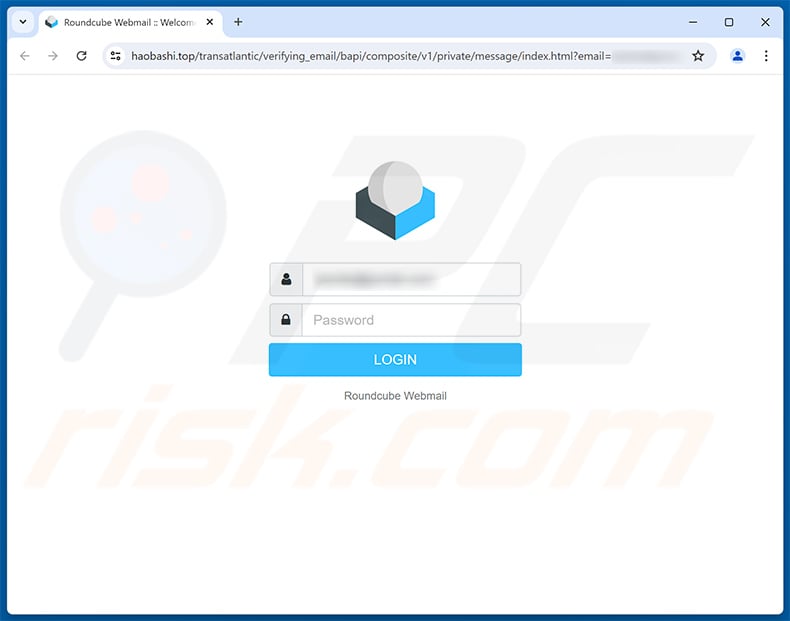
Instant automatic malware removal:
Manual threat removal might be a lengthy and complicated process that requires advanced IT skills. Combo Cleaner is a professional automatic malware removal tool that is recommended to get rid of malware. Download it by clicking the button below:
DOWNLOAD Combo CleanerBy downloading any software listed on this website you agree to our Privacy Policy and Terms of Use. To use full-featured product, you have to purchase a license for Combo Cleaner. 7 days free trial available. Combo Cleaner is owned and operated by RCS LT, the parent company of PCRisk.com.
Quick menu:
- What is A Spreadsheet Has Been Shared phishing email?
- Types of malicious emails.
- How to spot a malicious email?
- What to do if you fell for an email scam?
Types of malicious emails:
![]() Phishing Emails
Phishing Emails
Most commonly, cybercriminals use deceptive emails to trick Internet users into giving away their sensitive private information, for example, login information for various online services, email accounts, or online banking information.
Such attacks are called phishing. In a phishing attack, cybercriminals usually send an email message with some popular service logo (for example, Microsoft, DHL, Amazon, Netflix), create urgency (wrong shipping address, expired password, etc.), and place a link which they hope their potential victims will click on.
After clicking the link presented in such email message, victims are redirected to a fake website that looks identical or extremely similar to the original one. Victims are then asked to enter their password, credit card details, or some other information that gets stolen by cybercriminals.
![]() Emails with Malicious Attachments
Emails with Malicious Attachments
Another popular attack vector is email spam with malicious attachments that infect users' computers with malware. Malicious attachments usually carry trojans that are capable of stealing passwords, banking information, and other sensitive information.
In such attacks, cybercriminals' main goal is to trick their potential victims into opening an infected email attachment. To achieve this goal, email messages usually talk about recently received invoices, faxes, or voice messages.
If a potential victim falls for the lure and opens the attachment, their computers get infected, and cybercriminals can collect a lot of sensitive information.
While it's a more complicated method to steal personal information (spam filters and antivirus programs usually detect such attempts), if successful, cybercriminals can get a much wider array of data and can collect information for a long period of time.
![]() Sextortion Emails
Sextortion Emails
This is a type of phishing. In this case, users receive an email claiming that a cybercriminal could access the webcam of the potential victim and has a video recording of one's masturbation.
To get rid of the video, victims are asked to pay a ransom (usually using Bitcoin or another cryptocurrency). Nevertheless, all of these claims are false - users who receive such emails should ignore and delete them.
How to spot a malicious email?
While cyber criminals try to make their lure emails look trustworthy, here are some things that you should look for when trying to spot a phishing email:
- Check the sender's ("from") email address: Hover your mouse over the "from" address and check if it's legitimate. For example, if you received an email from Microsoft, be sure to check if the email address is @microsoft.com and not something suspicious like @m1crosoft.com, @microsfot.com, @account-security-noreply.com, etc.
- Check for generic greetings: If the greeting in the email is "Dear user", "Dear @youremail.com", "Dear valued customer", this should raise suspiciousness. Most commonly, companies call you by your name. Lack of this information could signal a phishing attempt.
- Check the links in the email: Hover your mouse over the link presented in the email, if the link that appears seems suspicious, don't click it. For example, if you received an email from Microsoft and the link in the email shows that it will go to firebasestorage.googleapis.com/v0... you shouldn't trust it. It's best not to click any links in the emails but to visit the company website that sent you the email in the first place.
- Don't blindly trust email attachments: Most commonly, legitimate companies will ask you to log in to their website and to view any documents there; if you received an email with an attachment, it's a good idea to scan it with an antivirus application. Infected email attachments are a common attack vector used by cybercriminals.
To minimise the risk of opening phishing and malicious emails we recommend using Combo Cleaner Antivirus for Windows.
Example of a spam email:

What to do if you fell for an email scam?
- If you clicked on a link in a phishing email and entered your password - be sure to change your password as soon as possible. Usually, cybercriminals collect stolen credentials and then sell them to other groups that use them for malicious purposes. If you change your password in a timely manner, there's a chance that criminals won't have enough time to do any damage.
- If you entered your credit card information - contact your bank as soon as possible and explain the situation. There's a good chance that you will need to cancel your compromised credit card and get a new one.
- If you see any signs of identity theft - you should immediately contact the Federal Trade Commission. This institution will collect information about your situation and create a personal recovery plan.
- If you opened a malicious attachment - your computer is probably infected, you should scan it with a reputable antivirus application. For this purpose, we recommend using Combo Cleaner Antivirus for Windows.
- Help other Internet users - report phishing emails to Anti-Phishing Working Group, FBI’s Internet Crime Complaint Center, National Fraud Information Center and U.S. Department of Justice.
Frequently Asked Questions (FAQ)
Why did I receive this email?
Phishing attacks entail sending a multitude of emails to recipients with the aim of deceiving them. Typically, these emails lack personalization and are sent indiscriminately to a wide audience.
I have provided my personal information when tricked by this email, what should I do?
Access your email account settings and change your password immediately. Also, report the phishing scam to the appropriate authorities, such as your email service provider.
I have downloaded and opened a malicious file attached to an email, is my computer infected?
It depends on the type of the file. For instance, executing a malicious executable file poses a significant risk of infection, whereas file formats like .pdf or .doc generally pose lower immediate threats (they cannot infect computers unless additional steps are taken).
I have read the email but did not open the attachment, is my computer infected?
Simply opening an email does not pose a risk. However, interacting with links or opening attachments within the email can lead to computer infections.
Will Combo Cleaner remove malware infections that were present in email attachment?
Combo Cleaner has the capability to detect and eradicate the majority of malware infections. However, in cases involving sophisticated malware, the malicious software can conceal itself deeply within the system. Therefore, conducting a thorough system scan is essential to eliminate hidden threats effectively.
Share:

Tomas Meskauskas
Expert security researcher, professional malware analyst
I am passionate about computer security and technology. I have an experience of over 10 years working in various companies related to computer technical issue solving and Internet security. I have been working as an author and editor for pcrisk.com since 2010. Follow me on Twitter and LinkedIn to stay informed about the latest online security threats.
PCrisk security portal is brought by a company RCS LT.
Joined forces of security researchers help educate computer users about the latest online security threats. More information about the company RCS LT.
Our malware removal guides are free. However, if you want to support us you can send us a donation.
DonatePCrisk security portal is brought by a company RCS LT.
Joined forces of security researchers help educate computer users about the latest online security threats. More information about the company RCS LT.
Our malware removal guides are free. However, if you want to support us you can send us a donation.
Donate
▼ Show Discussion